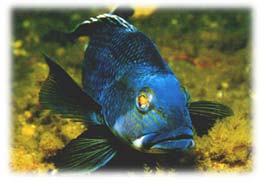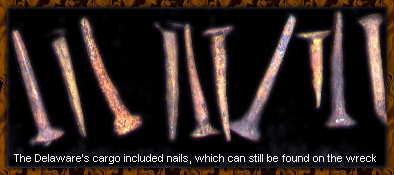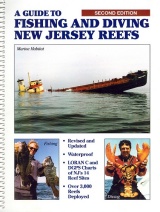Delaware (2/3)
NEW JERSEY'S DELAWARE
Is the Money-Filled Strongbox Still there?
Text and Photography by Herb Segars

In the latter days of June 1898, the Clyde Line steamer Benefactor foundered in the waters off Frying Pan Light, North Carolina. The steamer Delaware, on its way north from Charleston, South Carolina, took the Benefactor under tow to Red Hook, New Jersey. The Delaware continued on to its berth at Pier 29 on the East River, beneath the Brooklyn Bridge in New York. Little did anyone suspect this benevolent act would be the last complete voyage for the majestic steamer.
At 3:30 pm on Friday, July 8, the Delaware sailed from New York for Charleston, South Carolina, with 32 passengers, 34 crew members, and a cargo of nearly 1,000 tons. The ship cruised off Sandy Hook, New Jersey, under clear skies and in calm seas. The passengers enjoyed the view of the coastline and most turned in for the evening around 9:00 pm. The quiet night air was broken only by the humming of the steamer's engine and the slapping of the waves against the hull.
Close to 10:00 pm, crew members reported to the officer on the bridge that smoke was coming from the after hatch. Finding a raging fire below deck, the crew employed a standard shipboard firefighting technique, cutting holes in the deck and inserting water hoses. By the time they rolled the carpets and cut holes in the main salon deck, the fire was so intense that overpowering amounts of smoke poured through the holes.
The Delaware was about 10 miles east of Barnegat, New Jersey when the fire was discovered. Crew members fired rockets, hoping to alert passing ships or land-based lifesavers. The wooden steamer immediately headed west toward land and was about two miles off the beach when the fire broke through to the outside of the ship, lighting up the night sky.
Loss of life was prevented by the excellent performance of all crew members. First officer B. McBeth and stewardess Ella C. Hill went quietly from room to room, awakening passengers, informing them of the situation, and advising them to go to the top deck as a precautionary measure. Many passengers emerged from their cabins in a blinding smoke-filled labyrinth. The crew quickly responded by forming chains and passing passengers along hand-to-hand until all were safely on deck and near a lifeboat.
Captain Ingram's instructions were clear: Women and children into the lifeboats first! This order was obeyed without question. Except for a minor scuffle with two overzealous male passengers, the evacuation was textbook perfect. All of the women and children, with the exception of a young bride who refused to be separated from her husband, and the stewardess who declared that she would stand with the officers and crew, boarded the first lifeboat. Male passengers and some crew members occupied the remaining boats. Four of the five lifeboats were launched; the last was unreachable in the intense fire. The captain and the remaining crew members escaped on two life rafts fashioned by lashing together deck grating and hatch combings.

At Cedar Creek Life Saving Station No. 15, the first sign of disaster occurred at 10:00 pm with the sighting of the Delaware's red and white Coston signal. Station keeper Alex Brinley quickly signaled a red Coston signal reply. Although short-handed, they launched a heavy lifeboat whose crew performed a remarkable feat: rowing the five miles to the Delaware in an hour. The lifesaving crew relieved a few lifeboats of their passengers; the fishing smack Samuel B. Miller, of New York, arrived on site and took all the occupants of one lifeboat.
Dangerous surf conditions stopped any attempts at beaching the lifeboats at night. About 3:00 am, the tug Ocean King, moving north along the coast with barges in tow, spotted the Delaware's fire. The tug anchored the barges, moved in, and took all aboard save 12 crew members and the captain. These 13 stayed aboard the Samuel B. Miller and cruised around the Delaware to maintain possession of the steamer. The Ocean King returned to Clyde Line's pier, safely depositing her precious human cargo ashore. Sixty-six began the voyage, 66 were saved.
In hopes of salvage, the Merritt-Chapman Derrick and Wrecking Company dispatched the tug W.S. Chapman down the coast. She found the Delaware afloat and still burning despite a heavy mid-morning rain. One mast still stood, although the entire hull was burned to the waterline. In the midst of dense smoke that poured from the steamer, a line was secured to her and the tug slowly towed the Delaware northward.
Onlookers on the beach were treated to a sight as the caravan moved along the coast. Near Bayhead, New Jersey, the tug was seen to move away from the burning hulk and steam quickly northward. The reason was soon evident as the Delaware slipped beneath the sea to its watery grave. The loss of the ship and its cargo was valued at $250,000.
The Delaware lies in 76 feet of water one and a half miles off the coast of Bayhead. It is a 15 minute run from Manasquan Inlet and about 40 minutes from Shark River. It's an excellent second dive after a deeper offshore dive or a nice place to anchor for two dives. Additionally, her proximity to the coast makes her a choice spot when the winds are blowing hard out of the west. The Delaware is one of the few shipwrecks off New Jersey that can be found using land ranges.

The wreck lies north to south on a sandy bottom with the bow facing south. Most of the wreckage rises four or five feet off the bottom except for the 10 to 12 foot high boilers and engine. A diver can swim the fringes of the wreck from the bow to the steel propeller in one dive.
Artifact hunting is the most popular facet of diving the Delaware. Thousands of artifact dives have been made on the Clyde Line steamer and hundreds of square feet of sand have been searched in the hopes of finding a precious remnant of the past. It took 91 years for the shipwreck to yield its crown jewel-the ship's bell. In October of 1989, Pennsylvania diver Bill Davis uncovered the bell on a small section of wreckage off the main wreck. This find stunned hardcore New Jersey artifact hunters.
Almost every artifact conversation about the Delaware touches on the legend of a strongbox containing $250,000. Many believe it was removed before the ship went down. Others point to the statements of passengers describing the impossibility of entering the ship once the fire was raging. Perhaps it has already been found and not reported-or some lucky diver may find it tomorrow.
The Delaware is an excellent sightseeing dive, as long as the visibility is good. Its proximity to shore makes it susceptible to visibility lowering influences such as run-off. Its marine community includes Ocean Pouts, Sea Bass, Blackfish (Tautogs), Bergalls, sea anemones, barnacles, crabs, and our only coral species - the Northern Stony Coral. Large Conger Eels inhabit the nooks and crannies of the wreck by day and prowl openly at night. Those unprepared for the sight of a six-footer swimming into their light beams will suffer an immediate increase in heart rate. Underwater photography is usually limited to macro and close-up because of an average visibility of 10 to 15 feet. Of course, there are those days when visibility is great, exciting the sightseers, hunters, and underwater photographers. Artifact hunters, lost in their little clouds of disturbed sand, never know the difference.



The Delaware, a wooden steamship built in 1880, now lies beneath 75 feet of seawater just a few miles out of Manasquan Inlet (New Jersey). The ship, which burned and sank on July 9, 1898, was originally 252' long, 37' high, and 1279 tons.
She was bound from New York to Jacksonville with a cargo of general merchandise, 29 passengers, and 41 crew. All were safely evacuated once fire was discovered off Barnegat, but the Delaware slipped beneath the waves and was lost about three miles off Point Pleasant as she was being towed up the shore by a tug the following morning. The crew were commended for their courage and discipline, as the evacuation was very orderly, women and children first followed by the men passengers, the crew, and finally Captain A.D. Ingram.

The Delaware's cargo included nails, which can still be found on the wreck.
The Delaware is today one of the most visited wrecks for dive boats out of Manasquan inlet. Although she burned to the waterline before she sank, the wreck is definitely recognizable as the remains of a ship, with her boilers, engine, and propeller shaft providing good reference points for navigation. Despite the popularity of this site, a bit of digging (and a little luck) will still turn up interesting artifacts.
Original NJScuba website by Tracy Baker Wagner 1994-1996

